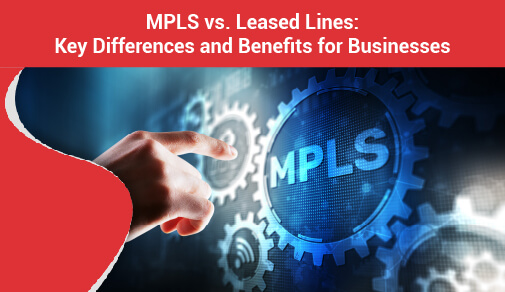MPLS vs. Leased Lines: Key Differences and Benefits for Businesses
-
171
-
06 Apr 2024
-
5 minutes

Leased lines and MPLS are considered the key business networking solutions for reliable and efficient data communication. Due to its sheer flexibility as well as diverse QoS functionality, MPLS fits into complex and multi-site situations. It routes data using labels for flexible, high-performance networking. For vital applications, leased lines provide dedicated, private connections with reliable, fast bandwidth that is secure. While leased lines offer simple, reliable connections, MPLS shines in flexibility and effective traffic control. The decision between them is based on particular business requirements, including the number of locations, bandwidth needed, and level of network complexity sought.
What Is MPLS and How Does It Work?
A high-performance, protocol-neutral network technology called multiprotocol label switching (MPLS) uses short path labels rather than lengthy network identifiers to direct data. By eliminating the need for laborious routing table lookups, this technique facilitates effective data routing and guarantees quicker and more dependable data transfer. Because of its scalability and quality of service (QoS) characteristics, which prioritize important traffic and improve speed, MPLS is perfect for companies with intricate multi-site networks. MPLS is a recommended option for enterprises requiring adaptable and reliable network solutions since it increases speed and efficiency by streamlining data pathways.
In order to make decisions about data forwarding, MPLS labels packets. This allows it to identify virtual links, or pathways, between distant nodes as opposed to endpoints. This labeling improves efficiency and speeds up network traffic flow. Because MPLS may function on several underlying technologies, such as ATM, Frame Relay, or IP, it offers scalability and flexibility for a wide range of network topologies. MPLS streamlines routing lowers latency, and boosts efficiency by labelling every packet.
What Is an Internet Leased Line and How Does It Work?
So, what is a leased line? It is a dedicated, symmetric telecommunications line providing fixed bandwidth for data transfer between two locations known as an internet leased line connection. A leased line is only used by the subscriber, as opposed to shared standard broadband connections, guaranteeing reliable and fast internet access. Due to its exclusivity, enterprises with vital applications requiring dependable connectivity may be sure of constant performance and minimal latency. Leased lines effectively support tasks like video conferencing, massive file transfers, and cloud services by offering symmetrical speeds for uploads and downloads.
Leased lines work in the context of the network of the service provider, and the user's location is linked directly. Today, leased lines are suitable for organizations that need high availability and avoid high latency since they essentially sell VoIP, video conferencing, and big data transfers. In any organization that has continuity, several operations that entail connectivity with extremely low latency needs are likely to rely on leased lines, as these networks are known to be extremely reliable. This dedicated service provides a strong and steady internet connection, which is necessary for contemporary company operations that call for dependable and fast data transmission capabilities.
Benefits of MPLS and Leased Lines for Businesses
The following are some key benefits of MPLS and the benefits of leased lines.
Benefits of MPLS:
1. Quality of Service (QoS): MPLS can prioritize different types of traffic, ensuring that critical applications receive the necessary bandwidth and low latency.
2. Scalability: MPLS networks can easily be expanded to accommodate growth without significant changes to the existing infrastructure.
Benefits of Leased Lines:
1. Guaranteed Bandwidth: An internet leased line connection provides a dedicated bandwidth that is not shared with other users, ensuring high performance and reliability.
2. Symmetrical Speeds: Leased lines offer equal upload and download speeds. It is beneficial for businesses that require substantial data transfer in both directions.
Difference Between Leased Line and MPLS
The following are some points of difference between leased line and MPLS:
| Leased Line | MPLS | |
| Purpose | Dedicated internet access with consistent performance. | Creating private, efficient networks that can prioritize traffic. |
| Bandwidth | Fixed, guaranteed bandwidth exclusively for the subscriber. | Shares bandwidth across multiple sites but can prioritize traffic to ensure performance. |
| Performance | High and consistent performance with low latency. | Reliable performance with built-in redundancy and failover mechanisms. |
| Security | Private connection, enhancing data security. | Offers a secure network through traffic segregation but shares infrastructure. |
Choosing the Right Solution for Your Business
When deciding between an internet leased line connection and MPLS, businesses should consider their specific needs and priorities:
1. Network Requirements
A leased line is the best option if your company needs guaranteed bandwidth, high-speed, and dependable internet. It provides dependable, dedicated connectivity, which is necessary for important processes. MPLS is a better option, nevertheless, for companies that need to prioritize and manage communication across several sites
2. Budget
When analyzing the financial effects, leased lines are often more costly because they are high-performance, dedicated lines that guarantee consistent and dependable bandwidth just for the customer. They are, therefore, perfect for crucial procedures, albeit at a premium price. On the other hand, because MPLS effectively routes traffic using shared infrastructure and offers great quality of service and prioritization capabilities, it can be more cost-effective, particularly for multi-site connectivity.
Conclusion
Businesses can benefit greatly from both MPLS and leased line connections, but which is best for them depends on the demands of the business. For organizations that need reliable and regular performance, leased lines offer symmetrical high-speed internet that is dedicated to them. On the other hand, MPLS provides scalable, adaptable, and efficient networking—especially useful for enterprises with several locations that require traffic to be prioritized. Businesses can select the best option by being aware of the main distinctions between flexible, multi-site connections with MPLS and dedicated performance with leased lines. Making this well-informed decision guarantees that operational needs and growth goals will have the appropriate networking support.






